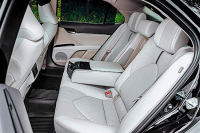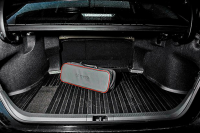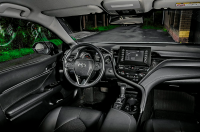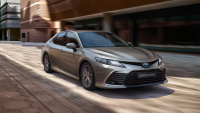 In fact, you're looking at two different Toyota Camrys. And in the sequel to this article, which will come out in a month, there will also be a third. And this detailed "buyer's notebook" on the entire family of one of Toyota's top bestsellers, I'm just typing it up, perched on its back sofa with light leather and personal touchscreen climate control with audio system. Business!
In fact, you're looking at two different Toyota Camrys. And in the sequel to this article, which will come out in a month, there will also be a third. And this detailed "buyer's notebook" on the entire family of one of Toyota's top bestsellers, I'm just typing it up, perched on its back sofa with light leather and personal touchscreen climate control with audio system. Business!
Toyota Camry.On sale: from 2021.
With the update, new 2.0-liter and 2.5-liter atmospheric gasoline Dynamic Force series "fours" under the hood of sedans. Image Camry with a V6 hasn't touched the hand of engineers. The starting motor with 150 hp and 206 "newtons" is friendly with variator Direct Shift-CVT, which is notable for presence of starting gear. Two hundred "horses" and 243 Nm in Camry 2.5 is digested and sent to the front wheels by 8-speed automatic Aisin. The former engines of the same volume were bolted on with automatic 6-speed gearboxes. In essence, all technology of the fresh Camry, including the GA-K platform, echoes the crossover RAV4 of the actual generation. Except for all-wheel drive, unfortunately.
In a two-liter sedan, you don't think about all-wheel drive. Even after the first acquaintance on the roads of the Krasnodar region, I praised Camry for exemplary balance in work of units. Engine M20A-FKS speeds up to working revolutions, starting gear in the variator helps intensive starts from a place up to about 25 km / h. In the range from zero to 90-100 km/h, dosing the traction is comfortable. Pressed the pedal, revolutions jumped up at once, and the 1,5-ton sedan speeds up briskly. However, after 100 km/h the pep charge naturally dries up.

The extra half a liter, 50bhp and 37Nm helps the Camry with the A25A-FKS engine feel more confident on the country lanes. But it is impossible to call a tandem of the 2.5 motor and 8-speed automatic faultless. The difference in acceleration from zero up to 100 km/h in 0,8 seconds is not appreciable. In the range of 30-100 km/h the 200 hp sedan moves briskly, than the younger model, but one can notice small pauses while the automatic shifts to lower one. The jerk from a place is perceived as less dynamic. Thus the Camry 2.5 doesn't hesitate to grind the front wheels when starting with a pedal to the floor. Power steering, typical of long front-wheel drive cars, in it is felt brighter. A full drive, in the manner of American specification of a sedan, could improve the habits of the automobile, add a palette of positive impressions from optimum balance between steerability and comfort, but alas. And it turns out, that the version 2.5 on the background of the younger one cannot offer any radical features concerning driving impressions. In addition the 200 hp engine is noisier and consumes more fuel - 10,5 against 9 liters of 95th in an active mode of driving.
I have traveled by Toyota Camry with different motors: I tell you which one I liked more and why

I'm deliberately not saying that the two-liter variant is better. Simply there are less claims to it. And here it would be possible to give you consumer advice to choose the younger Camry if not for one "but" - observance of a hierarchy in equipment. The configuration Classic is the top for Camry 2.0. it is stuffed with LED optics, 17-inch disks with Continental Premium Contact 5 215/55R17 tires, leather upholstery, two-zone climate control, cruise control, a rearview camera, heated front seats and side mirrors, electric heated wiper blade rest area, and electric adjustments of a driver's seat.

An exhaustive set, if we're talking about corporate use of the car. But if you want more, you'll have to consider a sedan with a 2.5 engine. There the space for equipment is wider. The top for such modification is the version Lux Safety which you just see in photos. The one that flaunts light interior, 18-inch wheels, electric adjustment of all seats, touchscreen control unit of the third climate zone and audio system on the second row, personal Wi-Fi access point, ventilated seats, electric heated steering wheel and windshield, 7-inch board computer display on instrument panel, solar curtains, wireless charging, support of Toyota Connected Services mobile application, and a whole lot of safety systems, included in Safety Sense package.

Expensive-rich? Well, not really. The media center, though friendly with smartphones via Apple CarPlay and Android Auto, is frustrating in terms of drawing and average image quality from the rearview camera. The steering wheel warms the hands only in the grip area on the sides. And there is no electric trunk lid closing mechanism in the most expensive set for 200-horsepower Toyota Camry.

In the second part, we'll put the image Camry with a V6 3.5 engine into "play," speculate about the need for all-wheel drive for a sedan, and traditionally calculate the costs of operating Toyota's best-selling car.


-rear-and-front-view-camera-6.png)

